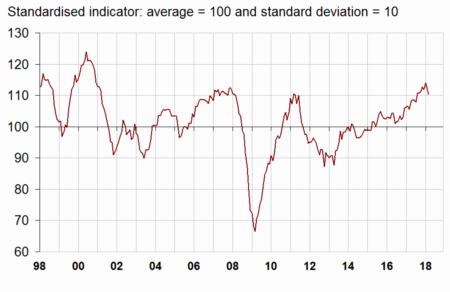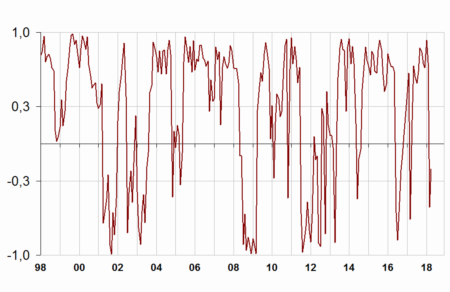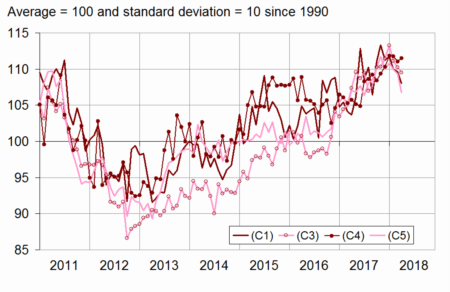 24 April 2018
2018- n° 101In April 2018, the business climate in manufacturing weakens slightly again Monthly business survey (goods-producing industries) - April 2018
24 April 2018
2018- n° 101In April 2018, the business climate in manufacturing weakens slightly again Monthly business survey (goods-producing industries) - April 2018
According to the business managers surveyed in March 2018, the business climate in industry is somewhat less favourable. The composite indicator has dipped by one point, after losing two points in February and in March. It had reached a seventeen-year peak at the beginning of the year. At 109, it remains well above its long-term average (100).
- The balance on past activity has dropped but production expectations have rebounded
- In the agrofood industry, the business climate is less favourable
- The business climate is stable in the manufacture of machinery and equipment goods
- The business climate remains at a high level in the manufacture of transport equipment
- The business climate has slightly fallen in “other manufacturing industries”
- Revisions
According to the business managers surveyed in March 2018, the business climate in industry is somewhat less favourable. The composite indicator has dipped by one point, after losing two points in February and in March. It had reached a seventeen-year peak at the beginning of the year. At 109, it remains well above its long-term average (100).
graphiqueGraph 1 – Business climate in industry - Composite indicator

The turning-point indicator stands in the uncertainty area.
graphiqueGraph 2 – Turning-point indicator

- How to read it: close to 1 (resp. -1), the indicator points to a favourable short-term economic situation (resp. unfavourable). The uncertainty area is between −0.3 and +0.3.
The balance on past activity has dropped but production expectations have rebounded
The balance of industrialists' opinion on past activity has drastically decreased and is back to its average level. Conversely, that on personal production expectations has rebounded and is back to its February level, well above its long-term average.
Manufacturers are also less optimistic about the general production prospects for the sector than at the beginning of the year – the corresponding balance had then reached its highest level since July 2000. Their opinion on overall and export order books is virtually stable, with corresponding balances slightly lower than in January and February when they had reached levels not seen since December 2007.
As many industrialists as in March consider that their finished-goods inventories are above normal. The corresponding balance remains below its long-term mean.
As regards employment, the balance of opinion on expected workforce size has slightly fallen after reaching in February its highest level since June 2011. That on past workforce size is stable. Both balances remain well above their long-term average.
tableauTable 1 – Industrialists' opinion on manufacturing activity
| Manufacturing industry | Ave.* | Jan. 18 | Feb. 18 | March 18 | April 18 |
|---|---|---|---|---|---|
| Composite indicator | 100 | 114 | 112 | 110 | 109 |
| Past activity | 5 | 23 | 19 | 17 | 5 |
| Finished-goods inventory | 13 | 3 | 5 | 5 | 5 |
| Overall order books | –18 | 2 | 2 | 1 | 0 |
| Export order books | –14 | 3 | 3 | 2 | 1 |
| Past workforce size | –10 | 5 | 5 | 4 | 4 |
| Expected workforce size | –12 | 3 | 5 | 5 | 3 |
| Personal production expectations | 5 | 20 | 15 | 9 | 15 |
| General production expectations | –8 | 34 | 30 | 26 | 24 |
- * Long-term average since 1976.
- Source: INSEE - Monthly business tendency survey in industry
In the agrofood industry, the business climate is less favourable
In the manufacture of food products and beverages, the business climate indicator has dipped by two points in April. At 108, it still remains well above its long-term average (100). The slight decrease mainly comes from the drop in the balances on past activity and on order books.
The business climate is stable in the manufacture of machinery and equipment goods
In the overall manufacture of machinery and equipment goods, the business climate remains at a high level after reaching a ten-year high in January. The decrease in the balances on past activity and on export order books is offset, notably by the increase in the balance on overall order books.
The business climate has slightly improved in the computer, electronic and optical product industry while it is stable in electrical equipment and machinery and equipment.
The business climate remains at a high level in the manufacture of transport equipment
In the manufacture of transport equipment, the business climate is up by one point, back to its January and February level, its highest since June 2001. This comes from the increase in the balances on export order books and on personal production expectations, partly offset by the decline in that on past activity.
The business climate indicator has slightly faltered in the manufacture of motor vehicles, trailers and semi-trailers, while remaining well above its average. In the manufacture of other transport equipment, however, it has slightly improved.
The business climate has slightly fallen in “other manufacturing industries”
In overall “other manufacturing”, the business climate has further deteriorated slightly. At 107, it remains however well above its long-term average. This slight drop is due to a decrease in the balances on export order books and on past and expected activity.
By subsector, the business climate indicator has declined in wood-paper, chemicals, clothing-textiles and in basic metals. It is stable in “other manufacturing industries” and has slightly picked up in rubber and plastic products.
graphiqueGraph 3 – Business climates in a sector-based approach

- Legend: (C1): Manufacture of food products and beverages - (C3): Machinery and equipment goods - (C4): Manufacture of transport equipment - (C5): Other manufacturing
tableauTable 2 – Business climates in a sector-based approach
| NA* : (A17) et [A38 et A64] | Weights** (%) | Feb. 18 | March 18 | April 18 |
|---|---|---|---|---|
| (C1) Man. of food products and beverages | 22 | 110 | 110 | 108 |
| (C3) Machinery and equipment goods | 11 | 111 | 110 | 110 |
| [CI] Computer, electronic and optical products | 3 | 110 | 107 | 108 |
| [CJ] Electrical equipment | 3 | 111 | 110 | 110 |
| [CK] Machinery and equipment | 5 | 109 | 110 | 110 |
| (C4) Man. of transport equipment | 15 | 112 | 111 | 112 |
| [CL1] Motor vehicles, trailers and semi-trailers | 7 | 113 | 113 | 112 |
| [CL2] Other transport equipment | 8 | 106 | 104 | 105 |
| (C5) Other manufacturing | 46 | 110 | 109 | 107 |
| [CB] Textiles, clothing industries, leather and footwear industry | 2 | 115 | 116 | 113 |
| [CC] Wood, paper, printing | 5 | 115 | 111 | 109 |
| [CE] Chemicals and chemical products | 9 | 105 | 108 | 105 |
| [CG] Rubber and plastic products | 7 | 113 | 109 | 110 |
| [CH] Basic metals and fabricated metal products | 11 | 108 | 107 | 104 |
| [CM] Other manufacturing industries | 9 | 106 | 105 | 105 |
- * NA: aggregated classification, based on the French classification of activities NAF rév.2.
- ** Weights used to aggregate sub-sector's balances of opinion.
- Source: INSEE - Monthly business tendency survey in industry
Revisions
The business climate in manufacturing in March 2018 has been lowered from 111 to 110 since its first estimation published in March, mainly due to the inclusion of late responses from businesses.
Documentation
Methodology (pdf,133 Ko)
Pour en savoir plus
Time series : Industry - Activity and demand




